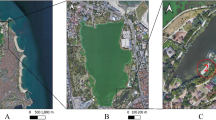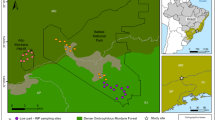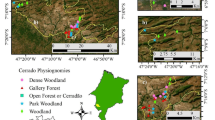Abstract
The location of pine marten records in northern Italy suggests that main rivers may play the role of natural corridors favouring this species’ colonisation of cultivated lowlands. We assessed the distribution and habitat use by the pine marten on a 35 km long stretch of the River Ticino. Surveys were carried out between October 2011 and June 2012 along linear transects in a 2 × 2 km grid. Using the variation in marking intensity as an indicator of habitat use, habitat selection was assessed at two landscape levels—at transect-scale by the χ 2 test with Bonferroni’s confidence intervals for the proportion of use, and at grid-scale by multiple linear regression. By a polymerase chain reaction–restriction fragment length polymorphism method, 91 faecal samples were assigned to the pine marten. Faeces were mainly located in wooded areas, while fields were avoided. At the grid-scale of analysis, marking intensity was positively related to the mean area of wooded patches and negatively to their mean perimeter-area ratio. This suggests that pine marten relative abundance may partially depend on the degree of fragmentation and structure of residual woods. The survey protocol allowed to assess the probability of detection. Occupancy models outlined that heterogeneity in detection probability may arise as a result of variation in marking intensity, i.e. the number of marking individuals. Our results suggest that the availability of both woodland corridors and wood patches are major factors shaping pine marten distribution in intensively cultivated plains and that non-invasive genetic surveys are a cost-effective method for future studies at a broader scale.




Similar content being viewed by others
References
Balestrieri A, Remonti L, Prigioni C (2009) Habitat selection in a low-density badger Meles meles population: a comparison of radio-tracking and latrine surveys. Wildl Biol 15:1–7
Balestrieri A, Remonti L, Ruiz-González A, Gόmez-Moliner BJ, Vergara M, Prigioni C (2010) Range expansion of the pine marten (Martes martes) in an agricultural landscape matrix (NW Italy). Mamm Biol 75:412–419
Balestrieri A, Remonti L, Prigioni C (2011a) Detectability of the Eurasian otter by standard surveys: an approach using marking intensity to estimate false negative rates. Naturwissenschaften 98:23–31
Balestrieri A, Remonti L, Ruiz-González A, Vergara M, Capelli E, Gómez-Moliner BJ, Prigioni C (2011b) Food habits of genetically identified pine marten (Martes martes) expanding in agricultural lowlands (NW Italy). Acta Theriol 56:199–207
Balharry D (1993) Social organization in martens: an inflexible system? Symp Zool Soc Lond 65:321–345
Beier P (1993) Determining minimum habitat areas and habitat corridors for cougars. Conserv Biol 7:94–108
Bennett AF (2003) Linkages in the landscape: the role of corridors and connectivity in wildlife conservation. IUCN, Gland, p 254
Bentley J, Catterall C (1997) The use of bushland, corridors, and linear remnants by birds in southeastern Queensland, Australia. Conserv Biol 11:1173–1189
Benton TG, Vickery JA, Wilson JD (2003) Farmland biodiversity: is habitat heterogeneity the key? Trends Ecol Evol 18:182–188
Bright PW (1993) Habitat fragmentation: problems and predictions for British Mammals. Mammal Rev 23:101–111
Burnham KP, Anderson DR (2002) Model selection and inference—a practical information-theoretic approach, 2nd edn. Springer, New York 488 pp
Buskirk SW (1992) Conserving circumboreal forests for martens and fishers. Conserv Biol 6:318–320
Buskirk SW, Zielinski WJ (2003) Small and mid-sized carnivores. In: Zabel CJ, Anthony RG (eds) Mammalian community dynamics: management and conservation in the coniferous forests of western North America. Cambridge University Press, Cambridge, pp 207–249
Byers CR, Steinhorst RK, Krausman PR (1984) Clarification of a technique for analysis of utilization-availability data. J Wildl Manag 48:1050–1053
Camerano P, Grieco C, Terzuolo PG (2010) I boschi planiziali: conoscenza, conservazione e valorizzazione. Regione Piemonte, Blu edizioni, Torino, p 167
Caryl FM, Quine CP, Park KJ (2012) Martens in the matrix: the importance of nonforested habitats for forest carnivores in fragmented landscapes. J Mamm 93:464–474
Clavero M, Prenda J, Delibes M (2006) Seasonal use of coastal resources by otters: comparing sandy and rocky stretches. Estuar Coast Shelf Sci 66:387–394
Clerici N, Vogt P (2013) Ranking European regions as providers of structural riparian corridors for conservation and management purposes. Int J Appl Earth Obs 21:477–583
Coles TF, Southey JM, Forbes I, Clough T (1989) River wildlife data bases and their value for sensitive environmental management. Regul Rivers 4:179–189
Davison A, Birks JDS, Brookes RC, Braithwaite TC, Messenger JE (2002) On the origin of faeces: morphological versus molecular methods for surveying rare carnivores from their scats. J Zool Lond 257:141–143
De Marinis AM, Masseti M (1993) Pine marten Martes martes on the island of Elba. Small Carniv Conserv 8:13
Del Fante S (2012) Comportamento spaziale della martora (Martes martes) in ambiente appenninico. Dissertation, Department of Earth and Environmental Sciences, Pavia University
Donovan TM, Hines J (2007) Exercises in occupancy modeling and estimation. http://www.uvm.edu/envnr/vtcfwru/spreadsheets/occupancy/occupancy.htm
Echeverría AI, Vassallo AI, Isacch JP (2006) Experimental analysis of novelty responses in a bird assemblage inhabiting a suburban marsh. Can J Zool 84:974–980
Garshelis DL (2000) Delusions in habitat evaluation: measuring use, selection, and importance. In: Boitani L, Fuller TK (eds) Research techniques in animal ecology: controversies and consequences. Columbia University Press, New York, pp 111–164
Genovesi P, De Marinis AM, (2003a) Martes foina. In: Boitani L, Lovari S, Vigna Taglianti A (eds), Fauna d’Italia Mammalia III, Carnivora—Artiodactyla. Calderini, Italy, pp 117–128
Genovesi P, De Marinis AM (2003b) Martes martes. In: Boitani L, Lovari S, Vigna Taglianti A (eds), Fauna d’Italia. Mammalia III, Carnivora—Artiodactyla. Ed Calderini, pp 106–117
Gese EM (2001) Monitoring of terrestrial carnivore populations. In: Gittleman JL, Funk SM, Macdonald DW, Wayne RK (eds) Carnivore conservation. Cambridge University Press, Ithaca, pp 372–396
Getz LL, Cole FR, Gates DL (1978) Interstates roadsides as dispersal routes for Microtus pennsylvanicus. J Mammal 59:208–212
Guter A, Dolev A, Saltz D, Kronfeld-Schor N (2008) Using videotaping to validate the use of spraints as an index of Eurasian otter (Lutra lutra) activity. Ecol Indic 8:462–465
Harris S, Woollard T (1990) The dispersal of mammals in agricultural habitats in Britain. In: Howard DC, Bunce RGH (eds) Species Dispersal In Agricultural Habitats. Belhaven Press, London, pp 159–188
Herr J, Schley L, Roper TJ (2009) Socio-spatial organization of urban stone martens. J Zool Lond 277:54–62
Hilty JA, Merenlender AM (2004) Use of riparian corridors and vineyards by mammalian predators in Northern California. Conserv Biol 18:126–135
Hines JE (2006) PRESENCE2—software to estimate patch occupancy and related parameters. USGS-PWRC. http://www.mbr-pwrc.usgs.gov/software.html
Jepsen JU, Topping CJ (2004) Modelling roe deer (Capreolus capreolus) in a gradient of forest fragmentation: behavioural plasticity and choice of cover. Can J Zool 82:1528–1541
Kauhala K, Salonen L (2012) Does a non-invasive method—latrine surveys—reveal habitat preferences of raccoon dogs and badgers? Mamm Biol 77:264–270
Kéry M (2002) Inferring the absence of a species—a case study of snakes. J Wildl Manage 66:330–338
Kohn MH, Wayne RK (1997) Facts from feces revisited. Trends Ecol Evol 12:223–227
Krebs CJ (1989) Ecological methodology. Harper and Row, New York 654 pp
Kruuk H, Conroy JWH, Glimmerveen U, Ouwerkerk EJ (1986) The use of spraints to survey populations of otters Lutra lutra. Biol Conserv 35:187–194
Lanszki J (2003) Feeding habits of stone martens in a Hungarian village and its surroundings. Folia Zool 52:367–377
Lanszki J, Hidas A, Szentes K, Révay T, Lehoczky I, Weiss S (2008) Relative spraint density and genetic structure of otter (Lutra lutra) along the Drava River in Hungary. Mamm Biol 73:40–47
Lassini P, Monzani F, Pileri P (2007) A green vision for the renewal of the Lombardy landscape. In: Pedroli B, Van Doorn A, De Blust G, Paracchini ML, Wascher D, Bunce F (eds) Europe’s living landscapes. Essays on exploring our identity in the countryside, Landscape Europe/KNNV, pp 83–100
Lepers E, Lambin EF, Janetos AC, DeFries R, Achard F, Ramankutty N, Scholes RJ (2005) A synthesis of information on rapid land-cover change for the period 1981–2000. Bioscience 55:115–124
Long RA, Donovan TM, MacKay P, Zielinski WJ, Buzas JS (2011) Predicting carnivore occurrence with noninvasive surveys and occupancy modeling. Landsc Ecol 26:327–340
Lucentini L, Vercillo F, Palomba A, Panara F, Ragni B (2007) A PCR-RFLP method on faecal samples to distinguish Martes martes, Martes foina, Mustela putorius and Vulpes vulpes. Conserv Genet 8:757–759
MacKenzie DI, Bailey L (2004) Assessing fit of site occupancy models. J Agric Biol Ecol St 9:300–318
MacKenzie DI, Nichols JD, Lachman GB, Droege S, Royle JA, Langtimm CA (2002) Estimating site occupancy rates when detection probabilities are less than one. Ecology 83:2248–2255
MacKenzie DI, Nichols JD, Hines JE, Knutson MG, Franklin AD (2003) Estimating site occupancy, colonization and local extinction probabilities when a species is not detected with certainty. Ecology 84:2200–2207
Mantovani S (2010) Recenti segnalazioni della martora, Martes martes, in provincia di Cremona. Pianura 25:95–107
Matson PA, Parton WJ, Power AG, Swift MJ (1997) Agricultural intensification and ecosystem properties. Science 277:504–509
Mazerolle MJ (2006) Improving data analysis in herpetology: using Akaike’s information criterion (AIC) to assess the strength of biological hypotheses. Amphibia Reptilia 27:169–180
McArdle BH (1990) When are rare species not there? Oikos 57:276–277
Mergey M, Helder R, Roeder J-J (2011) Effect of forest fragmentation on space-use patterns in the European pine marten (Martes martes). J Mammal 92:328–335
Messenger JE, Birks JDS (2000) Monitoring the very rare: pine marten populations in England and Wales. In: Griffiths HI (ed) Management and conservation aspects of small carnivore: human interactions. Backhuys Publishers, Leiden, pp 217–230
Mettke-Hofmann C, Winkler H, Leisler B (2002) The significance of ecological factors for exploration and neophobia in parrots. Ethology 108:249–272
Moritz C, Patton JL, Conroy CJ, Parra JL, White GC, Beissinger SR (2008) Impact of a century of climate change on small-mammal communities in Yosemite National Park, USA. Science 322:261–264
Mortelliti A, Amori G, Capizzi D, Rondinini C, Boitani L (2010) Experimental design and taxonomic scope of fragmentation studies on European mammals: current status and future priorities. Mammal Rev 40:125–154
Musiani M, Mamo C, Boitani L, Callaghan C, Gates CC, Mattei L, Visalberghi E, Breck S, Volpi G (2003) Wolf depredation trends and the use of fladry barriers to protect livestock in Western North America. Conserv Biol 17:1538–1547
Naiman RJ, Décamps H, Pollock M (1993) The role of riparian corridors in maintaining regional biodiversity. Ecol Appl 3:209–212
Neu CW, Byers CR, Peek JM, Boy V (1974) A technique for analysis of utilization-availability data. J Wildl Manag 38:541–545
O’Mahony D, O’Reilly C, Turner P (2012) Pine marten (Martes martes) distribution and abundance in Ireland: a cross-jurisdictional analysis using non-invasive genetic survey techniques. Mamm Biol 77:51–357
Olson CA, Beard KH, Koons DN, Pitt WC (2011) Detection probabilities of two introduced frogs in Hawaii: implications for assessing non-native species distributions. Biol Invasions. doi:10.1007/s10530-011-0125-5
Pereboom V, Mergey M, Villerette N, Helder R, Gerard JF, Lodé T (2008) Movement patterns, habitat selection, and corridor use of a typical woodland-dweller species, the European pine marten (Martes martes), in fragmented landscape. Can J Zool 86:983–991
Pilot M, Gralak B, Goszczyński J, Posłuszny M (2006) A method of genetic identification of pine marten (Martes martes) and stone marten (Martes foina) and its application to faecal samples. J Zool Lond 271:140–147
Posada D, Buckley T (2004) Model selection and model averaging in Phylogenetics: advantages of akaike information criterion and bayesian approaches over likelihood ratio tests. Syst Biol 53:793–808
Pőyry J, Luoto M, Heikkinen RK, Kuussaari M, Saarinen K (2009) Species traits explain recent range shifts of Finnish butterflies. Glob Change Biol 15:732–743
Prigioni C (1995) Guidelines for the feasibility study of reintroduction of the otter Lutra lutra in Italy: the project of the Ticino Valley (north-western Italy). In: Prigioni C (ed), Proc II It Symp on Carnivores Hystrix (ns) 7(1–2):225–264
Prigioni C, Balestrieri A (2011) Piano di monitoraggio dei Vertebrati terrestri di interesse comunitario in Lombardia: lontra Lutra lutra. Università di Pavia, Dipartimento di Biologia Animale 30 pp
Putman RJ (1984) Facts from faeces. Mammal Rev 14:9–97
Quinn GP, Keough MJ (2002) Experimental design and data analysis for biologists. Cambridge University Press, Cambridge
Rangel TF, Diniz-Filho JAF, Bini LM (2010) SAM: a comprehensive application for spatial analysis in macroecology. Ecography 33:1–5
Reed JM (1996) Using statistical probability to increase confidence of inferring species extinction. Conserv Biol 10:1283–1285
Reed DH (2004) Extinction risk in fragmented habitats. Anim Conserv 7:181–191
Remonti L, Balestrieri A, Ruiz-González A, Gómez-Moliner BJ, Capelli E, Prigioni C (2012) Intraguild dietary overlap and its possible relationship to the coexistence of mesocarnivores in intensive agricultural habitats. Popul Ecol 54:521–532
Rosalino LM, Santos MJ, Beier P, Santos-Reis M (2008) Eurasian badger habitat selection in Mediterranean environments: does scale really matter? Mamm Biol 73:189–198
Rosellini S, Osorio E, Ruiz-González A, Pineiro A, Barja I (2008) Monitoring the small-scale distribution of sympatric European pine martens (Martes martes) and stone martens (Martes foina): a multievidence approach using faecal DNA analysis and cameratraps. Wildl Res 35:434–440
Royle JA, Nichols JD (2003) Estimating abundance from repeated presence-absence data or point counts. Ecology 84:777–790
Ruiz-González A, Rubines J, Berdiόn O, Gómez-Moliner BJ (2008) A non-invasive genetic method to identify the sympatric mustelids pine marten (Martes martes) and stone marten (Martes foina): preliminary distribution survey on the northern Iberian peninsula. Eur J Wildl Res 54:253–261
Ruiz-González A, Madeira MJ, Randi E, Urra F, Gómez-Moliner BJ (2013) Non invasive genetic sampling of sympatric marten species (Martes martes and Martes foina): assessing species and individual identification success rates on faecal DNA genotyping. Eur J Wildl Res 59:371–386
Sacchi O, Meriggi A (1995) Habitat requirements of the stone marten (Martes foina) on the Tyrrhenian slopes of the northern Apennines. In: Prigioni C (ed), Proc III Symp on Carnivores Hystrix (ns) 7:99–104
Sadlier MJ, Webbon CC, Baker PJ, Harris S (2004) Methods of monitoring foxes Vulpes vulpes and badgers Meles meles: are field signs the answer? Mammal Rev 34:75–98
Slauson KM, Baldwin J, Zielinski WJ, Schwartz M (2009) Estimating detection probabilities for fishers using non-invasive methods and implications for survey protocols. U.S. Fish and Wildlife Service, Yreka Field Office and the Fisher Science Team, pp 68
Sugiura N (1978) Further analysis of the data by Akaike’s information criterion and the finite corrections. Comm Statist Theory Methods A7:13–26
Taylor PD, Fahrig L, Henein K, Merriam G (1993) Connectivity is a vital element of landscape structure. Oikos 68:571–573
Virgós E, Zalewski A, Rosalino LM, Mergey M (2012) Habitat ecology of genus Martes in Europe: a review of the evidences. In: Aubry KB, Zielinski WJ, Raphael MG, Proulx G, Buskirk SW (eds) Biology and conservation of marten, sables, and fisher: a new synthesis. Cornell University Press, New York, pp 255–266
Waldron JL, Bennett SH, Welch SM, Dorcas ME, Lanham JD, Kalinowsky W (2006) Habitat specificity and home-range size as attributes of species vulnerability to extinction: a case study using sympatric rattlesnakes. Anim Conserv 9:414–420
Warkentin IG, Greenberg R, Ortiz JS (1995) Songbird use of gallery woodlands in recently cleared and older settled landscapes of the Selva Lacandona, Chiapas, Mexico. Conserv Biol 9:1095–1106
White GC, Garrott RA (1990) Analysis of wildlife radio-tracking data. Academic Press, USA, p 386
Zalewski A, Jedrzejewski W (2006) Spatial organisation and dynamics of the pine marten Martes martes population in Bialowieza Forest (E Poland) compared with other European woodlands. Ecography 29:31–43
Acknowledgments
This study has been partially supported by the Basque Government through the Research group on “Systematics, Biogeography and Population Dynamics” (Ref. IT317-10; IT575-13). Aritz Ruiz-González (Ref: DKR-2,012-64) and Maria Vergara (Ref: RBFI-2,012-446) were supported by a post-doctoral and PhD fellowships awarded by the Dept. of Education, Universities and Research of the Basque Government. We thank Pietro Tirozzi and Andrea Serioli, who helped with sample collection in the field for their degree theses. Lesley C. Wright kindly revised the paper for English language use. The comments of two anonymous reviewers helped to improve the final version of the manuscript.
Author information
Authors and Affiliations
Corresponding author
About this article
Cite this article
Balestrieri, A., Remonti, L., Ruiz-González, A. et al. Distribution and habitat use by pine marten Martes martes in a riparian corridor crossing intensively cultivated lowlands. Ecol Res 30, 153–162 (2015). https://doi.org/10.1007/s11284-014-1220-8
Received:
Accepted:
Published:
Issue Date:
DOI: https://doi.org/10.1007/s11284-014-1220-8




